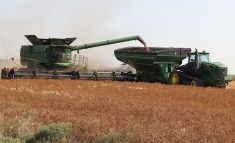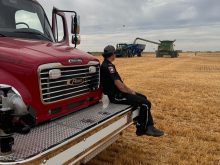Glacier FarmMedia – It was an otherwise nondescript day in 1992 when Darrell Newman started up a ladder to the top of his hopper bin to make sure the grain wasn’t beginning to heat.
It was a climb he had made hundreds of times before without incident on his mixed farm near Ashern, Man. This time, though, when he was 12 to 15 feet above the ground, the ladder started to fall backward.
Afraid that he would land on a parked tillage rig below, he managed to swing the ladder out and lock his legs. It wasn’t enough to save him from injury.
Read Also

Alberta researcher helps unlock the economics of farming
Lethbridge Polytechnic researcher helping agriculture producers with decision-making tools in economic feasibility
“When I hit the ground, that’s when my right leg tipped and I blew my ankle up. My right leg — after they did the X-rays at the local hospital — was in 18 pieces,” Newman recalled.
He ended up going through five surgeries over five years in an attempt to repair the leg before he made the decision to amputate.
Now retired (he still worked the farm for seven years after the accident), Newman hopes today’s farmers can avoid similar tragedy. He’s spent the last decades as an advocate and educator for grain safety.
He was responsible for not securing the ladder before attempting the climb, he said. His message to farmers includes urging them to slow down and be more mindful of what they’re doing at all times.
This year’s harvest season means another safety push from organizations such as the Canadian Agricultural Safety Association (CASA).
The months from July to October post the highest number of agriculture-related fatalities, according to a report from the association’s Canadian Agriculture Injury Reporting initiative, aggregating data from 2003-12. July and September together accounted for almost a quarter of deaths, while another 22 per cent happened in August and October. Of those, the vast majority involved being run over, rolled over, entangled in or pinned by machinery.
There’s also another danger repeatedly highlighted by CASA: grain entrapment.
The Canadian Agriculture Injury Reporting initiative has found that farm deaths from choking on grain or soil increased 5.1 per cent each year between 1990 and 2015. From 2006-15, 30 people (about 83 per cent of asphyxiation deaths) died from choking on grain or silage. Looking at a more recent window, from 2011-20, the initiative found 27 fatalities from grain or soil asphyxiation.
The BeGrainSafe program, which was launched in 2017 in response to an increase in grain entrapment fatalities, offers prevention education, rescue training for firefighters and on-site workplace training to heighten awareness about grain hazards.
“Grain entrapment is a significant safety risk anywhere that grain is stored — and it can happen in the blink of an eye,” CASA’s executive director, Sandra Miller, said in a release.
There are plenty of things farmer’s can do to reduce grain, bin and other farm accidents, said Catherine Rylatt, founder and vice-president of the Grain Handling Safety Coalition, one of CASA’s partners.
Tip 1: Never forget your lock-out tags
This involves rendering equipment unable to be turned on, which reduces the risk of accidental burials or injuries when farmers are in a bin.
Locking out equipment takes just a few steps, but failing to use lockout tags is still the leading cause of entrapments and engulfments, Rylatt wrote in an email.
“Turn off the equipment, disconnect it from the power source, ‘lock out’ the power source so no one can accidentally turn it on,” she said.
Keep the keys on you rather than in the equipment so that no one else can unlock it, and “put a tag on it so people know it is locked out,” she said.
“Get a lockout tagout kit from your supplier. They are not that expensive and go a long way to saving people from injury, provided they are used each and every time.”
Tip 2: Don’t rely on rescues or ‘gimmicks’
Don’t count on a rescue, wrote Rylatt — “chances are they won’t make it in time.”
It only takes a few seconds to be engulfed and, once it happens, the odds of survival plummet, CASA warns.
Producers are also advised against “gimmicks” to skirt proper safety procedures.
“For a while people were buying respirators because it saved the life of a person in Iowa until he was rescued — but barely,” Rylatt warned.
Far better would have been to follow better safety procedures.
Farmers are also often told to harness up before making a significant climb, such as entering a bin at height.
Tip 3: Check in
Rylatt is emphatic on this point: tell someone where you’ll be and what you’re doing.
“Do regular check-ins. Some of the saddest cases are hearing that people didn’t realize someone was missing, injured, engulfed, etc., until the evening when they don’t show up,” she said.
Many producers work alone, a point also noted by various farm safety organizations. That’s never recommended if going in a bin, although solo operators often find it difficult to find someone to be there with them.
“Check-ins are very important with a family member, neighbour, etc,” Rylatt said.
She’s seen first-hand the kind of tragedy that can occur for lack of a quick phone call or sticky-note on the kitchen refrigerator.
Long before she started the coalition, “a co-worker of my husband’s didn’t show up for work on Monday morning,” she wrote via email.
“This was highly unusual as he didn’t call either. They knew he was going to be mowing/haying over the weekend, so (they) decided to call the sheriff.”
When they located him, it was too late.
“They found him under his tractor. He had been trapped since Saturday morning. The autopsy revealed he passed just a few hours before they found him. It was truly horrific and gut wrenching.”
Tip 4: Maintenance, suitable clothing crucial
Make sure your bins, ladders, catwalks and equipment are in good repair and well-maintained, Rylatt said. Appropriate clothing is also a must.
“Make sure all guards are in place and working properly,” she said.
“Never step across a moving p.t.o. or conveyor. Don’t wear loose clothing around machinery. Remove jewelry, ties (like on hoodies) and keep hair secured if it is long. Use proper ladder procedures when ascending/descending.… Don’t forget about heat stress signs and understand your physical capabilities.”
The last point is directed particularly at older producers and those on medications that may impair ability.
“As we get older and especially on certain medications, our balance can be affected — not a good thing if climbing ladders, etc.,” said Rylatt.
She also urged producers to bear the inconvenience and use personal protection equipment, which includes dust masks.
“Be aware of dust accumulation and follow the standards, as it can be explosive,” she said.
“Keep the area around the bins clean, free of debris, mowed, etc., to discourage critters.
“Before storing new grain, thoroughly clean those bins and make repairs if needed, and thoroughly clean the harvesting equipment. Follow your rules for slow-moving and large vehicles and make sure they have the appropriate signage, lights, etc., before harvest starts.”
Tip 5: Don’t neglect your health
Rylatt strongly recommended that producers pay attention to all facets of their health, including mental health. Harvest is stressful.
“Get good restorative sleep, stay hydrated (not with caffeine or alcohol), eat healthier meals, take rest breaks, get some exercise like yoga or a walk for both physical and mental health,” she wrote.
“Stretch the muscles before a long, hard day — especially true for us older folks to reduce the risk of strains and sprains.”
Never hesitate to ask for help, especially if a job is too much for one person, she added.
And whatever you do, don’t rush.
“Rushing leads to bad decisions. No matter what, take the time to do what needs to be done safely. It only takes mere seconds to be injured, and those injuries can impact you and your loved ones long term — physically, mentally, financially, etc.
“The goal is always to return home at the end of your work day.”
It’s a message that farmers need to continue to hear, says Newman.
“With a lot of these accidents, when I sat down with other farmers that had accidents, you get into a repetition. Farming is so automatic in some ways, you don’t even think about it. I climbed those bins hundreds of times … and then I made one mistake. I didn’t secure the ladder quite right. And it bit me.”
















